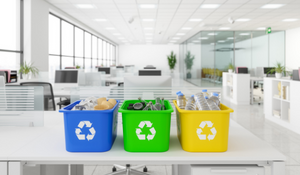Rethinking the Workplace: How Millennials and Gen Z are Influencing Office Design
Does upgrading office space encourage your employees to show up and work in it? Many U.S. companies are banking on it. The pandemic has had a monumental impact on the workforce, forcing companies to rethink how their employees work and how to best support them.
In the last couple of years, companies have reevaluated their working scenarios and made changes to ensure safety and well-being and attract and retain a new wave of employees as they join the workforce. By 2025, Millennials (ages 26-41) are projected to make up more than 50% of the global workforce. This, along with the introduction of Gen Z (ages 10-25), means the needs of employees will be changing drastically in the coming years. Companies will need to have a workplace that younger generations of employees will want to work in.
So, before you bring employees back into the office, take some time to understand what younger generations of employees want in terms of design and culture. From digital transformation to collaborative layouts to flexible work arrangements — fostering the right work environment can go a long way in attracting and retaining top talent. The work environment you create directly supports potential Millennial and Gen Z employees to do their best work. Here’s a look at how companies utilize some office design trends to ensure their spaces are more inviting to the younger generations of employees.
Embrace Technology
Millennial and Gen Z employees are highly tech-savvy, as you can probably guess. A Fundera survey found that 91% of Gen Z workers are interested in a workplace with sophisticated technology. And a Dell & Intel Future Workforce Study showed that 42% of Millennials stated they would leave a company if faced with “substandard technology.” New generations of employees are looking to the latest devices and software, including smart/powered furniture, tools for video conferencing, cross-device integrations, as well as cloud-based and virtual collaboration opportunities. Creating a tech-friendly, modernized workplace allows your employees to maximize their productivity in the ways they are most adept, which is highly beneficial to talent retention.
Balancing Collaboration & Privacy
It’s becoming increasingly clear that the younger generations of employees are looking for the best of two worlds: collaboration and privacy. The trend of open office design is a clear opportunity for co-working spaces, but it shouldn’t overshadow providing a variety of spaces for different work styles. That could include private areas to take calls, quiet zones for focused work, and social hubs where employees can take breaks and reenergize. By striking the right social-private balance in the workplace, employees can better work together while also finding space for undisturbed concentration when needed.
Flexible Furniture
In order to accomplish a tech-supported, mix-style office space, companies should focus on creating flexible working environments that are dynamic and responsive to the work being done. No one is looking to work at a desk for 8 hours a day. This places a big emphasis on remote working or different work settings, which can contribute to creativity and productivity. This could include conference rooms, casual seating, desks with adjustable heights, and chairs with removable backrests — all with the goal of providing employees with the ability to change their scenery.
Sustainable Design and Practices
Millennials and Gen Z employees have voiced the importance of climate consciousness in nearly every facet of life, including their workplaces. The younger generations of employees are looking for companies that emphasize sustainability in their ethos and have workspaces that are proactively eco-friendly. According to a survey by Fast Company, nearly 40% of Millennials have chosen a job because of company sustainability. Nearly 70% of respondents said that if a company had a strong sustainability plan, it would affect their decision to stay with that company long term. Deloitte’s 2021 Millennial and Gen Z Survey revealed both generations are continuing to demand social change and accountability — meaning green design and practices are no longer optional if you want to woo top talent.
Value Alignment
Knowing what younger generations of employees want from their workplace is half the battle; companies need to align values that support employees. According to Deloitte’s 2019 Global Millennial Survey, 22% of millennials and 19% of Gen Z workers said they would consider leaving employers that don’t prioritize flexible working or support a healthy work-life balance. A LinkedIn Workplace Culture report found that 86% of Millennials would even consider taking a pay cut to work at a company whose mission and values align with their own. This means companies looking to attract and maintain top talent need to cultivate a culture that meets the needs of potential Millennial and Gen Z employees and the values they have.
The Takeaway
Companies today need to adapt and change to meet the needs of an evolving workforce. Enhancing technology, reevaluating design to create unique environments, and fostering a culture that supports employees' values are just a few ways a company can become more inviting to the next generation of workers. Through several surveys and research, it’s been determined that Millennials and Gen Z employees who like working from their office are significantly less likely to leave and are more engaged, productive, and connected to their company culture. Millennials and Gen Z are the fastest-growing segments of the workforce, so it only stands to reason that companies should act now to provide the culture and space needed to attract and retain top talent.

%20(1)-1.png)

